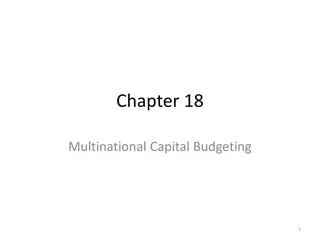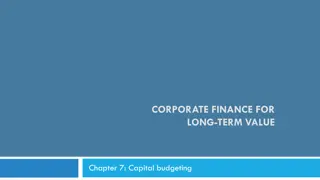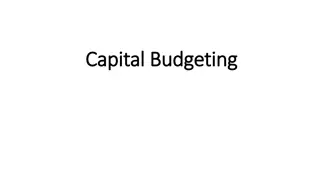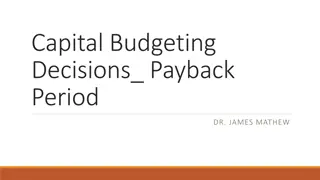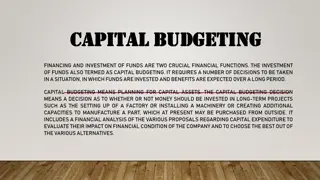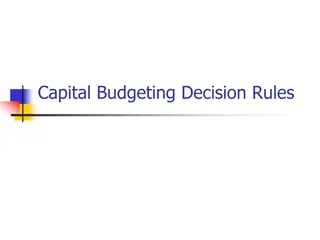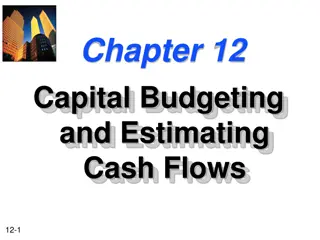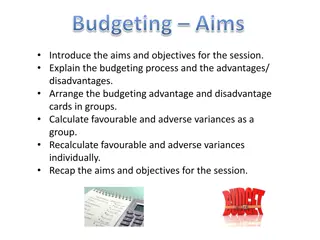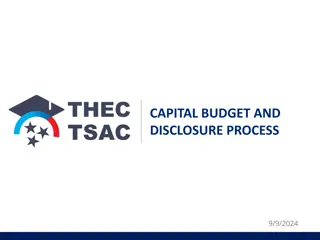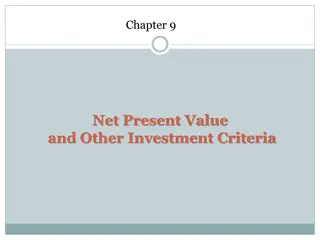Investment Decisions and Capital Budgeting Overview
Investment decisions and capital budgeting are crucial processes in which firms assess the acquisition of fixed assets. This involves evaluating projects based on various methods such as out of pocket commitment, pay back period, and average annual rate of return. The significance of investments lies in substantial expenditure, long-term implications, and sales forecasts. Understanding the time value of money is key, as investors prefer present consumption over future payments to account for opportunity costs. Through cash flow analysis and the consideration of cash flows occurring at different time points, firms can make informed decisions regarding their capital budget.
Download Presentation

Please find below an Image/Link to download the presentation.
The content on the website is provided AS IS for your information and personal use only. It may not be sold, licensed, or shared on other websites without obtaining consent from the author. Download presentation by click this link. If you encounter any issues during the download, it is possible that the publisher has removed the file from their server.
E N D
Presentation Transcript
Chapter 4 Investment Decisions (Capital Budgeting)
Investment Decisions (Capital Budgeting) EVALUATION METHODS 1. Out of Pocket Commitment : The out of pocket commitment is the total expense required for an alternative. 2. Pay Back Period: The pay back period for an investment is the number of years it takes to repay the original invested capital 3. Average Annual Rate of Return: The alternatives are evaluated on the basis of only the average rate of return as expressed in terms of a percentage (of the original capital).
Introduction Investment (Capital Budgeting) is decision making process by which firms evaluate the purchase of fixed assets It is the whole process of analyzing projects and deciding which ones to include in the capital budget. Capital Budget is an outline of the planned investment in fixed assets Significance of investment: - substantial expenditure - long time period - sales forecasts
4.1. The time value of money Investor prefer to receive payment of a fixed amount of money today, rather than an equal amount in the future. Why? - people prefer current consumption to future - to account for opportunity cost (to the least the interest payment)
4.1. The time value of money(cont) 0 1 2 3 r % CF0 CF1 CF2 CF3 Show the timing of cash flows. Time Line:- Tick marks occur at the end of periods, so Time 0 is today; Time 1 is the end of the first period (year, month, etc.) or the beginning of the second period.
4.1. The time value of money(cont) General Assumption: Cash Flows (CFs) occur at the END of the period, unless stated otherwise. Payments (PMTs) occur at the END of the period (ordinary annuity), unless stated otherwise.
4.1. The time value of money(cont) CFs can either be: a) Lump Sum (Birr1000 to be received in 1 year or 5 years, or Birr1000 invested today), or b) Recurring CFs (non-constant CFs), e.g. B100 in YR1, B200 in YR 2, B300 in YR3) or c) Stream of Constant PMTs (constant CFs, e.g. B100 per year for 3 years).
Financial investments involve cash flows occurring at different points in the time series. cash flows have to be brought to the same point 1. Present and future value of a single amount Simple interest: no interest is earned on the interest interest is accounted only for the principal FVn= PV (1+nr)
FVn= PV (1+nr) Where, PV= is the value at time=0 FV= is the value at time=n r=is the rate at which the amount will be compounded each period n= is the number of periods
Compound interest: interest payment is reinvested. FV = PV (1+r)n Where, PV= is the value at time=0 FV= is the value at time=n r= is the nominal interest rate (stated interst rate or annual %age rate) n= is the number of years
Classifications of interest rates Nominal rate (r) also called the quoted or state rate. An annual rate that ignores compounding effects. r is stated in contracts. Periods must also be given, e.g. 8% Quarterly or 8% Daily interest. Periodic rate (i) amount of interest charged each period, e.g. monthly or quarterly. i = r/m, where m is the number of compounding periods per year. m = 4 for quarterly and m =12 for monthly compounding.
Classifications of interest rates Effective (or equivalent) annual rate (reff) the annual rate of interest actually being earned, accounting for compounding. reff for 10% semiannual investment reff = ( 1 + r/m)m - 1 = ( 1 + 0.10 / 2 )2 1 = 10.25%
Relationship b/n PV and FV Comp. Interest Simple Interest FV PV Period
2. Present Value of uneven series Present value of uneven cash flow stream 1 0 2 3 I% CF0 A1 A2 A3 r = discount rate PVn = A1+ A2 + (1+r)2 An (1+r)n .+ (1+r)1 (1+r)1
3. Present Value of Annuity Constant cash flow at regular interval of time. 1 0 2 3 I% CF0 A A A r(1 - ) PVn = A( ) 1 1 (1+r)n 4. Future Value of Annuity FVn = A( ) r (1+r)n - 1
4.2 Investment Appraisal Investment proposals are evaluated from different dimensions: Economic evaluation Social benefit Environmental impact Consistent with local and nation development plan Others . Topic focus: Economic evaluation for investment appraisal
4.2 Investment Appraisal (cont) Important investment evaluation methods: 1. payback period 2. Net Present Value (NPV) 3. Internal Rate of Return (IRR) 4. Cost-Benefit Analysis 5. Cost-effective Analysis 6. Multi-criteria Analysis 7. Liner programming 8. Dynamic Programming
4.2.1 The Payback Period Payback period is the expected number of years required to recover the original investment. It measures risk, not return. The shorter the payback period, the more desirable will be the project First the maximum acceptable payback period (nmax) is specified against which the calculated payback period (n) is compared.
4.2.1 The Payback Period (cont) If It means... Then... n < nmax the investment would return the cost earlier than the expected time The project may be accepted n > nmax the investment would return the cost later than expected time The project should be rejected The project may be accepted but other evaluation method can also be used n = nmax The investment would return the cost exactly at the expected time
4.2.2 The Net Present Value (NPV) Standard method for the financial appraisal of long-term projects Used for capital budgeting, and widely throughout capital budgeting economics economics, it measures the excess or shortfall of cash flows, in present value (PV) terms, once financing charges are met. Indicator of how much value an investment or project adds to the value of the firm. present value
4.2.2 NPV (cont) NPV is calculated as: NPV = Bt (1 + r)-t - Ct (1 + r)-t Where, Bt = Benefit or return at the end of year t Ct = Cost outlay or investment at the end of year t r = required return (discount rate) n n t=1 t=1 t = time of the cash outlay n = total time of the project
4.2.2 NPV (cont) In financial theory, if there is a choice between two mutually exclusive alternatives, the one yielding the higher NPV should be selected The rate used to discount future cash flows to their present values is a key variable of this process Most firms have a well defined policy regarding their capital structure, so the weighted average cost of capital (after tax) is used as the discount rate Another method is to use a variable discount rate with higher rates applied to cash flows occurring further along the time span, (reflecting the yield curve premium for long-term debt). weighted average cost of capital
4.2.2 NPV (cont) It is appropriate to use higher discount rates to adjust for risk for riskier projects If a project offers a high risk, the reqiured return on the project will also be high. Expected Return Degree of Risk
4.2.2 NPV (cont) Procedure for analysis using NPV Find the present value of each cash flow, including both inflows and outflows, discounted at the projects cost of capital Sum this discounted cash flows: NPV Evaluate based on the value of 2 above 1. 2. 3. 0 1 2 3 100.00 10 60 80 9.09 49.59 60.11 NPV = 18.79
4.2.2 NPV (cont) If It means...Then... the investment would add value to the firm the investment would subtract value from the firm NPV > 0 The project may be accepted NPV < 0 The project should be rejected We should be indifferent in the decision whether to accept or reject the project. This project adds no monetary value. Decision should be based on other criteria, e.g. strategic positioning or other factors not explicitly included in the calculation. the investment would neither gain nor lose value for the firm NPV = 0
4.2.3 Internal Rate of Return (IRR) Is the discount rate that equates the present value of the project s expected cash inflow s to the present value of the project s costs. PVinfows = PVinvestment costs IRR is a rate that brings NPV=0 0 1 2 3 100.00 10 60 80 100.00 NPV = 0
Comparing NPV and IRR The use of the IRR always leads to the selection of the same project, project selection using the NPV method depends on the discount rate chosen, NPV and IRR could result in different selections
4.2.4 The Cost Benefit Ratio (CBR) It is similar to NPV in the way one compares the value added. Compares the value added per the cost incurred and used to evaluate projects of different sizes. n = n + 1 1 ( ) B r t = 1 t CBR = t + 1 1 ( ) C r t 1
Cash Flow Forecasting The most important, but also the most difficult, step in capital budgeting is estimating projects cash flows The investment outlays and the annual net cash inflows after a project goes into operations Relevant Cash flows The specific cash flows that should be considered in a capital budgeting decisions. Rules: Capital budgeting decisions must be based on cash flows, not accounting income. Only incremental cash flows are relevant. Costs that occur iff we accept the project. 1. 2.
Cash Flow Forecasting Annuity Constant stream of payments Lease, rent, etc Random Construction business for contractors is expected to be increasing Individual contract amount takes the form of the S-curve The Cash flows typically include the following items: Initial investment outlay Operating cash flows over the project s life Terminal year cash flows 1. 2. 3.
4.3 Capital Budgeting on Contract investment Cash flows of a construction company occur as a result of the contractual and credit arrangements existing on a series of contracts within any trading period. Sources of finance on contracts: Internal Source - generated from the companies operation - most of they are locked up b/c: Stage payment Disagreement External Sources - from lenders based on interest
4.3.1 Establishing ROCE and Mark up in Corporate Budget Planning The two parameters that affect a construction company s profitability: 1. The company's ROCE 2. The mark-up on contract costs to achieve the desired ROCE To determine firm s mark-up target, it is required establish: i) Return on Capital Employed (ROCE) Represents return anticipated by the company in relation with the total capital employed. Successful measurement of profitability Starting parameter for budgeting and performance measurement Determined at the head office level Collected from cash flow of individual contract through inclusion of Mark-up
ROCE is made to account for the following costs: The average weighted cost of capital (interest of capital employed) Profit margin (dividends, capital reserves...) Corporate obligations such as taxations and deprecation costs. Contingencies to cover uncertainties (Risks) ii) Annual Turnover on contracts. This can be obtained from the firm s short-term plan committed or planned for execution in the current year.
iii) General overhead costs (off-site administration): One of the items in the Mark-up Costs entitled in administrating the company and providing off-site services The amount of GOC for individual project is decided by management as part of their policy. Vary with individual firms, but broadly includes (within a company s accounts ) - rent on office and yard - fees, salaries and wages for directors and office staff - office equipment, stationary, telephones, cars - office heating and lighting - insurance on office and staff Estimated as the percentage of expected turnover
Steps to reach at companys Mark- up Step 1. Estimate total capital to be employed for the fiscal year (TCE) - estimated from the Balance Sheet of the Company Assets Liabilities Current Assets Cash . Marketable securities . Account Receivables . Inventories .. Other current assets . Fixed assets Buildings . Machineries Equipments .. Land .. Current Liabilities Short term loans Account payable . Accrued income taxes . Current payments due on Long-term dept .. Other current liabilities .
Steps to reach at companys Mark-Up (cont) Step 2.Determine ROCE as the percentage of the TCE. - Average weighted cost of capital (interest of capital employed) ***% TCE - Profit Margin (dividends and reserves) .***% TCE - Corporate obligations (tax, deprecation) .***% TCE - Contingencies to cover uncertainties (risk) ..***% TCE ROCE . ***% TCE Step 3.Estimate expected turnover for the fiscal year This can be obtained - from the firm s short-term plan committed, or - planned for execution in the current year.
Steps to reach at companys Mark-Up (cont) Step 4.Determine the General Overhead Cost (GOC) - Estimated as the percentage of the annual turnover - based on the previous year s turnover GOC ***% Turnover Step 5.Determine the Mark-up Mark-up (Head Office) = GOC + ROCE Step 6.Determine the Total Production Cost (TPC) Production Cost = Turnover Mark-up Step 7.Determine Mark-up individual Project mark-up mark-up at individual project = *100% TPC
Example The following is the balance sheet of a G5 contractor. Additional information are also outlined following this. Assets Liabilities Current Assets Current Liabilities 550,000 450,000 Fixed assets Loans 153,234 Preference shares 11,766 Share Capital 32,080 Retained Earnings 132,920 Total L and E 780,000 230,000 . Total Assets: 780,000
Example (contd) 1. Total Capital Employed (TCE from the BS) 2. The following shows return on the capital employed: i. ii. iii. iv. Average weighed cost of capital .6.5% Profit margin: .....6% Corporate obligations 4.5% Contingences to cover uncertainties ..3% 3. Planned total turnover The company is planning for a total turnover of Birr2,500,000 in the fiscal year 4. Administrative Expense The previous year s overhead cost was Birr150,000 while its total turnover was Birr2,000,000.
1. Estimate the total mark-up of the company at the head office and the mark-up on individual contracts. The company is invited to tender for a construction of a school building with a direct cost of Birr2,000,000 and estimated site overhead of 6%. What will be the minimum amount of the contract price that will be offered by the procurement committee? 2.
4.3.2 The Corporate Budget is the starting point for setting up a monitoring and reporting system reference point against which the measurement of financial performance and the achievement of planned objectives are made Corporate Budget (Cash Outlay) = Administrative Cost + Capital Required by Individual Contracts This has to be balanced with: Capital Budget (Cash Inflow) = Net Working Capital + Finance Sources (Debt, Sales of stocks, Sales of Fixed Assets)
4.4 A System of control levels There are different control levels in a construction company: 1. Managing Director Level 2. Contracts Management level 3. Site management level
Control Responsibility Components Managing Director Level Major Contracts production Costs Administrative Expenses Return on Capital Employed Contract Management Level Production Costs of Different Contracts Site Management Level Direct Cost of projects: Labor Cost Material Cost Plant Cost
Responsibility level Responsibilities Statement used Turnover Control Overhead control Account Management Corporate budget (master Budget) General Management Contract Budget Statement Operational Budget Statement Control Statement Contract Cost Management Contracts Management Activity Cost Statement Operational statement Site Management Activity Cost Control





